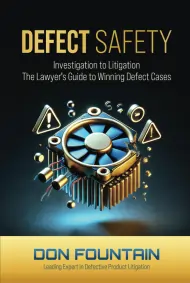What is the Duty Owed in a Florida Products Liability Case?
There are generally four categories of products liability claims. These include claims based on negligence, strict liability and breach of warranty. Under Florida law (as well as in most states), a plaintiff pursuing a negligence claim must establish:
- A legal duty on the part of the at-fault party to protect the party seeking
- relief under the circumstances;
- A negligent failure by the defending party to comply with the duty owed;
- An injury by the party seeking relief; and
- Damages
See Cintron v. Osmose Wood Preserving, Inc., 681 So.2d 859, 861 (Fla. 5th DCA 1996). In the context of products liability, manufacturers have a duty to exercise reasonable care so that their products placed in the marketplace will not harm persons or property. Id. at 861-62, citing Monsanto Agricultural Products Co. v. Edenfield, 426 So.2d 574 (Fla. 1st DCA 1982). In automotive defect cases, courts are sometimes called on to decide whether a defective component in an automobile was “a foreseeable consequence of the defendant’s negligence in designing or manufacturing” the defective part. Kikis v. Ford Motor Co., 386 So.2d 306, 307 (Fla. 5th DCA 1980).
In Kikis, the Fifth DCA had to decide whether a plaintiff’s injury in an auto defect case was the foreseeable result of the manufacturer’s negligence. There, the court held that “[a] foreseeable consequence is not what possibly might occur, or always occurs, but rather is a consequence which may be reasonably anticipated as a likely result of an act.” Id. at 307. The plaintiff in Kikis cut tendons and muscles in his hand as a result of the handling of the vehicle’s hubcap. Following a trial, the jury entered an award for the plaintiff, however, the court granted the defendant’s motion for directed verdict.
On appeal, the Fifth District reversed the trial court, instead finding that the plaintiff’s injuries to his hand could be found to be a likely result of the sharp edges surrounding the hubcap. Id. The court went on to find that in resolving the issue of the foreseeability of the injury, the jury verdict was proper. Id. Firestone Tire & Rubber Co. v. Lippincott, 383 So.2d 1181 (Fla. 5th DCA 1980), provides yet another example of a court addressing the foreseeability of injury in products liability action based on negligence. In Lippincott, the court noted that a “foreseeable consequence is one which a prudent man would anticipate as likely to result from an act.” Id. at 1182 (further citations omitted). Further, the consequences that a prudent man would anticipate, the court explained, “are those consequences that happen so frequently that they may be expected to happen again and are, therefore, probable consequences.” Id. citing Cone v. Intercounty Telephone & Telegraph Co., 40 So.2d 148 (Fla. 1949). Foreseeable consequences are not “what might possibly occur.” Id., citing Stanage v. Bilbo, 382 So.2d 423 (Fla. 5th DCA 1980).
Product liability law continues to evolve. Regarding a defendant’s duty owed to the plaintiff, more recent decisions focus on whether the defendant’s conduct foreseeably created a broader “zone of risk” that poses a general threat of harm to others. McCain v. Florida Power Corp., 593 So.2d 500 (Fla. 1992). Here, Florida courts follow other jurisdictions in recognizing that a legal duty will arise whenever a defendant engages in conduct (through manufacturing or otherwise), that creates a “generalized and foreseeable risk of harming others.” Id. at 503, citing Kaisner v. Kolb, 543 So.2d 732 (Fla. 1989)(holding that where a defendant’s “conduct creates a foreseeable zone of risk, the law generally will recognize a duty placed upon [the] defendant either to lessen the risk or see that sufficient precautions are taken to protect others from the harm that the risk poses.”).
Establishing the defendant’s duty owed is critical to the plaintiff’s success in a product defect action based on negligence. The McCain decision is helpful to plaintiffs as the Florida Supreme Court recognized that “trial and appellate courts cannot find a lack of duty if a foreseeable zone of risk more likely than not was created by the defendant.” Id. at 503. As the risk grows, so too does the defendant’s duty owed to the plaintiff. Id. This is because “the risk to be perceived defines the duty that must be undertaken.” Id., citingJ.G. Christopher Co. v. Russell, 58 So. 45 (1912).

